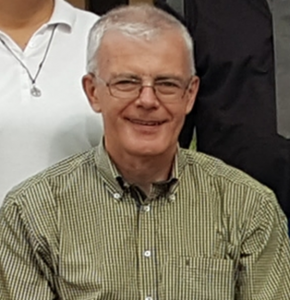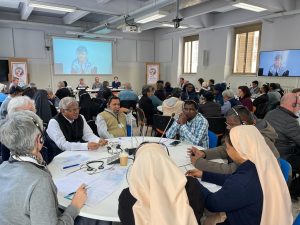Reflection: Solidarity with South Sudan
 I would like to thank the organisers for inviting a representative of Solidarity with South Sudan to give a short presentation on this subject. We are a collaborative venture between congregations from conception, birth and continue to be so 15 years after starting our first projects in South Sudan.
I would like to thank the organisers for inviting a representative of Solidarity with South Sudan to give a short presentation on this subject. We are a collaborative venture between congregations from conception, birth and continue to be so 15 years after starting our first projects in South Sudan.
For those of you that are not familiar with the project, allow me to give a short explanation of how it started.
Origins
The congress of religious life, held in 2004, was a moment of great importance of Solidarity with South Sudan. At the end of that Congress, a book was produced called ‘Passion for Christ, Passion for Humanity’. Two icons were used to represent the primal energies that inspired the Congress: the image of the Samaritan Woman at the well with a spiritual thirst for God, a thirst that is never quenched. The second image was of the Good Samaritan, the perennial call to show the mercy and healing of God to our neighbour, wherever she or he is to be found. It represented a fundamental affirmation of the basic impulses of religious lie and mission, along with the desire that these find new forms of expression at the start of a new millennium.
The following year, some Bishops from Southern Sudan came to Rome with the cry ‘help us’. They realised their need was greater than the capacity of any one congregation to respond to, and that is why they appealed for assistance to the JPIC group in Rome, which is intercongregational in its composition. This group in turn saw the need to present the Bishops’ petition to both female and male intercongregational associations, and undertook some preliminary investigations on their behalf.
Double Collaboration:
Solidarity was born out of this, an intercongregational initiative of both USG and UISG to launch a ‘new paradigm for religious life’ in Collaboration with the Bishops of South Sudan. Solidarity is therefore intercongregational in its origin and composition and collaborative in mission with the Episcopal Conference of Sudan and South Sudan in its implementation. A double collaborative venture!
It is important to state that from its conception and inspiration, Solidarity is an intercongregational initiative of female and male congregations, along with lay members. I think this is one of the great strengths of Solidarity. It is not a project that was started by one or two religious groups and was then opened up to others. Its very foundation, its mission and vision statements, its core values, even the modalities of its projects in South Sudan and the Fundraising necessary to sustain these, all these were discussed and agreed at intercongretational level from the outset. This is one of the strong positive underpinnings of Solidarity and helps explain why it has endured for so long as a project jointly owned by so many.
Equal Participation
It is true that at the very beginning 2 congregations were identified as founding members, the Comboni Sisters and the De La Salle brothers. However, in searching for the new wine skin, or paradigm, for the new wine of intercongregational apostolic mission, it was quickly realised that this was not an appropriate model. In fact, there were several congregations that lent significant support from the outset. Solidarity, or rather the congregations who gave birth to it, had to imagine and create an entirely unique structure for Solidarity.
Two concrete expressions of this in South Sudan are:
In none of our communities will you find a photo of a particular congregational founder or foundress in a public space. This can be a challenge for one or other member who thinks their founder is particularly indispensable. Members are encouraged to speak about their founders or their congregations in community fora. No one congregation can claim proprietorial ownership or rights over Solidarity at any level of its structures or activities.
Secondly, there is no one foundational spirituality for Solidarity. Each member is encouraged to express their own spiritualty in community, in prayer and to be open to participate and learn from others.
One positive implication of this is that congregations who were unable to fully participate at the origin of Solidarity and who now wish to become more active, these congregations are able to find a respected place where they can contribute within the existing framework on an equal basis.
It is true that the majority of congregations who have joined Solidarity have their Headquarters in Rome, but there are a significant number of participating international congregations who are based outside of Rome. Perhaps the fact that Solidarity was founded by the USG/UISG, which has a global reach, is important in this regard. No one select group of congregations can claim privileged rights, although there is an open group of 45-65 congregations who attend the Annual Assemblies and various other Solidarity events in Rome. This is not an exclusive club.
Initial Energy
It is hard to imagine now the excitement that was generated around the Solidarity project at the start: An intercongregational project of both men and women focusing on a country ravaged by decades of civil conflict and which would soon before the newest independent African state. Add to this mix, the undefined expectation of starting a new paradigm of religious living, and you can understand why up to 400 congregations were associated with this undertaking at the very start.
Having such a wide base to call upon means that there is a great diversity that is put at the service of one mission, an efficient pooling of resources, both in terms of personnel and expertise that any one congregation would struggle to find. This ‘effectiveness and efficiency’ aspect of pooling resources should not be overlooked, but neither should it be seen as the only or even primary motivation for working together. The richness in diversity is equally compelling argument.
Continuity of Commitment
One challenge that Solidarity has along with other intercongregational initiatives is that while the project belongs to everyone, no one congregation feels ultimately responsible for Solidarity’s wellbeing and success. Individual Superior Generals can be highly motivated, but sometime this motivation does not pass to members of their Councils, and with the arrival of a new congregational leadership group, sometimes the message or the enthusiasm does not pass from one group to the other. Or it can be that the new group wishes to focus on new priorities. None of this is a death sentence to Solidarity, it simply means that more work has to be done to continually reconnect with newer leadership groups.
Individual Choice and commitment:
I am associated with Solidarity in South Sudan for 4 years. During this time, we had Covid and lockdown. All through the civil war of 2013 to 2016, and afterwards, Solidarity never closed its doors. However, the corona virus ensured that we had to stop our activities with students, beneficiaries etc. In addition, we unable to meet as a group. Since the end of the Covid restrictions, we had met twice in annual assemblies. An outstanding impression of these meetings is how each member was positive about the mission and work of Solidarity. There was and is a remarkable energy and belief in the richness of the intercongregational approach to mission.
I attribute this to the depth of personal choice that each one was made in coming to Solidarity. This is not a mission that one stumbles on by accident, because there is nothing better to do or because one’s ‘Superior’ has told one to go. Arriving in Solidarity is the result of a free choice and a personal discerning on the
individual’s behalf. There can be many reasons for failing in South Sudan, with the plethora of challenges due to different cultures, trauma, ongoing insecurity, wide spread poverty rampant corruption. One basic reason for enduring, enjoying and contributing positively is based on the quality of one’s personal choice to join such a venture. This is an indispensable element for fulfilling collaboration in any intercongregational affair. This is always a role for discerning the suitability of individuals and the appropriateness of their skill sets and qualifications, but all this is premised on a fundamental option to live and work intercongregationally.
the plethora of challenges due to different cultures, trauma, ongoing insecurity, wide spread poverty rampant corruption. One basic reason for enduring, enjoying and contributing positively is based on the quality of one’s personal choice to join such a venture. This is an indispensable element for fulfilling collaboration in any intercongregational affair. This is always a role for discerning the suitability of individuals and the appropriateness of their skill sets and qualifications, but all this is premised on a fundamental option to live and work intercongregationally.
Knowing that you are living with like-minded people, who come from very different backgrounds, experiences, cultures, also feeds this personal commitment. Seeing how others, who are very different, remain positive in the face of challenges and setbacks, how they resource themselves personally, and how they are willing to reach out and support others, is a great encouragement. Words to not do justice to that.
Diversity as witness
The composition of the group varies from year to year. The beginning was marked by a number of long serving members will all have left by the end of 2023. Currently we are, 21 members in South Sudan, from 13 nationalities and 16 congregations. Diversity is the middle name of Solidarity, diversity in Nationalities, congregations, professional and religious education, work experience, spiritualities and operative theologies. Male and Female working side by side and forming religious communities together. The largest nationality grouping has three members and the largest congregational grouping has two members. We are very diverse, conscious of that and knowing that no one cultural way can dominate.
There is no initiation course into this ‘stew’. We all need to learn ‘on the job’ and to remind each other if we are insensitive to difference. This takes a certain willingness to hold one’s own ways in question, to be able to hear and accept the questions of others, and to be able to change! None of this is perfect. We all are on learning curves, both as individuals and as communities. While we are intentional in our desire to create and maintain intercongregational communities of diversity, this is not our sole aim.
An important counterbalance is the realisation that we are not in South Sudan to be a religious or social experiment, but to be of service to the church and society – in a divided, contested and sometimes violent world. There are an estimated 64 ethnic groups in South Sudan, 60 different local languages. The country is scarred by conflict which is expressed in ethnic terms, us and them, Dinka and Nuer, Nilotic and Bantu, pastoralists and agriculturalists.
Our communities of diversity see themselves as offering a model for our students to see different cultures living in harmony and working together for a common good that serves all. Intercongregational communities are not fashionable experiments but ways of prophetic witness in countries which are fracturing and vilifying difference.


